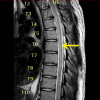Transient Neurogenic Bowel Dysfunction in a Case of Cocaine-Induced Spinal Cord Infarction
- PMID: 35530927
- PMCID: PMC9072291
- DOI: 10.7759/cureus.23834
Transient Neurogenic Bowel Dysfunction in a Case of Cocaine-Induced Spinal Cord Infarction
Abstract
A 23-year-old male presented to the hospital with altered mental status (AMS) and hypoglycemia requiring admission to the ICU. He had improvement in AMS after administration of dextrose 50% and naloxone and endorsed the use of alcohol, cocaine, and marijuana that morning. It was confirmed with a positive urine toxicology screen for cocaine and tetrahydrocannabinol (THC). During this hospital admission, his physical examination was notable for paraplegia with no motor abilities from the T6 dermatome and below. Sensation was intact throughout all dermatomes but he was found to have urinary retention. Workup included an abnormal MRI showing T2 signal spanning from T2-T8, raising a high suspicion of a probable acute ischemic spinal cord infarction. Several hours after admission, the patient began to exhibit the first signs of abnormal bowel function and experienced one episode of hematemesis, prolonging his ICU stay.
Keywords: cocaine; constipation; neurogenic bowel dysfunction; spinal cord infarction; upper gastrointestinal bleeding.
Copyright © 2022, Nieto et al.
Conflict of interest statement
The authors have declared that no competing interests exist.
Figures
Similar articles
-
Cocaine-Related Acute Spinal Cord Infarction.R I Med J (2013). 2018 Feb 2;101(1):28-29. R I Med J (2013). 2018. PMID: 29393308
-
Acute complete paraplegia of 8-year-old girl caused by spinal cord infarction following minor trauma complicated with longitudinal signal change of spinal cord.Eur Spine J. 2017 May;26(5):1432-1435. doi: 10.1007/s00586-017-4995-9. Epub 2017 Mar 9. Eur Spine J. 2017. PMID: 28281001
-
Digital subtraction angiography does not reliably prevent paraplegia associated with lumbar transforaminal epidural steroid injection.Pain Physician. 2012 Nov-Dec;15(6):515-23. Pain Physician. 2012. PMID: 23159970
-
Cocaine-related cervical spinal cord infarction: a case report and review of the literature.J Med Case Rep. 2022 Feb 2;16(1):59. doi: 10.1186/s13256-021-03223-4. J Med Case Rep. 2022. PMID: 35109933 Free PMC article. Review.
-
MRI diagnosis of spinal cord infarction: report of a case.J Formos Med Assoc. 1995 Jan-Feb;94(1-2):63-6. J Formos Med Assoc. 1995. PMID: 7613238 Review.
Cited by
-
Case Report: Toxic megacolon secondary to chronic constipation and cocaine consumption.Front Surg. 2024 Aug 21;11:1434523. doi: 10.3389/fsurg.2024.1434523. eCollection 2024. Front Surg. 2024. PMID: 39233765 Free PMC article.
References
-
- Spinal cord infarction secondary to cocaine use. Schreiber AL, Formal CS. Am J Phys Med Rehabil. 2007;86:158–160. - PubMed
-
- Central nervous system infarction related to cocaine abuse. Daras M, Tuchman AJ, Marks S. https://doi.org/10.1161/01.STR.22.10.1320. Stroke. 1991;22:1320–1325. - PubMed
-
- Spinal cord infarction: etiology and outcome. Cheshire WP, Santos CC, Massey EW, Howard JF Jr. Neurology. 1996;47:321–330. - PubMed
-
- Cocaine-induced spinal cord infarction. Jumma O, Koulaouzidis A, Ferguson IT. Postgrad Med J. 2008;84 - PubMed
-
- Primary CNS vasculitis with spinal cord involvement. Salvarani C, Brown RD Jr, Calamia KT, et al. Neurology. 2008;70:2394–2400. - PubMed
Publication types
LinkOut - more resources
Full Text Sources


